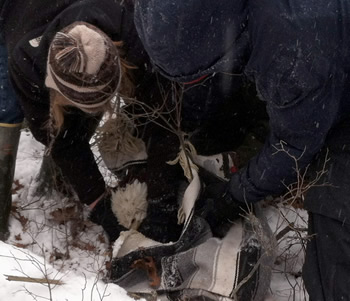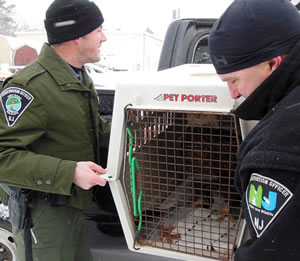Bald Eagle Rescue in Egg Harbor Townshipby Kathleen Clark Golf course staff start work early in the morning, even in the middle of winter. On February 1, the grounds keepers at Hidden Creek Golf Club in Atlantic County called the NJ Department of Environmental Protection's Hotline (877-WARN-DEP) to report a bald eagle, injured and grounded, on a remote fairway on the Egg Harbor Township club. The call, received by Kris Schantz of the Division's Endangered and Nongame Species Program, at home, was relayed to me, also still at home. As I headed out to gather the necessary equipment, I called Conservation Officer Doug Ely, who has helped on other eagle rescues. As much as we tried to rush to respond, everything seemed to move slowly: an unexpected snowstorm was quickly laying down 6-8 inches, making travel hazardous in the most southern counties. After a quick stop at my Tuckahoe office to get an eagle-sized pet carrier and heavy-gauge gloves, I carefully negotiated the roads through Atlantic County. Meanwhile, Lt. Ely had arrived at the golf course and scoped out the eagle's situation. The bird had made a short flight off the fairway into open woods, but then remained grounded. Through binoculars, he could see that something was wrong with the face. A closer look would reveal the right eye was injured.
Conservation Officers drove Eagle B/47 in a relay to Tri-State Bird Rescue and Research in Newark, Delaware, that day. The wildlife veterinarians at Tri-State are especially skilled with birds and treat more bald eagles than any center in our region. She was anesthetized for closer examination and x-rays, and her wounds were cleaned and treated. Her injuries were apparently the result of combat with another eagle, going by the puncture wounds in her face and near her eye. Aerial fights between eagles occur as they compete for nest sites, and it helps assure that only the healthiest and most fit eagles will reproduce. But such competition has been a very rare occurrence in New Jersey, as eagles have expanded into empty habitat. Serious competition among eagles has been seen for years in the Chesapeake Bay region, where the population across Maryland and Virginia has recently surpassed 1,000 pairs. We may see more of these injuries as eagles become more common across New Jersey.
One of the rewards of a healthy, recovered bald eagle population is the chance to see an eagle nearly anywhere in New Jersey. From Sussex to Cape May, bald eagles are calling the state home, and they can be seen along many of our waterways and state lands. Their recovery is a living symbol of the success of the state's Endangered and Nongame Species Conservation Act, enacted 40 years ago. The Endangered and Nongame Species Program continues work to recover rare wildlife, and keep "common" species common. Please remember the Endangered and Nongame Species Program as tax season approaches. Check-off for the N.J. Endangered Wildlife Fund on Line 59 of the New Jersey State Income Tax form. RELATED PAGES
|
||||||
|
||
|
|
||
|
||


